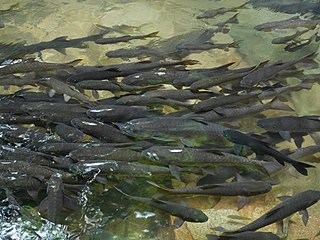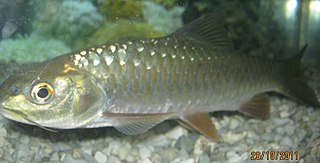
Mahseer is the common name used for the genera Tor, Neolissochilus, Naziritor and Parator in the family Cyprinidae (carps). The name is, however, more often restricted to members of the genus Tor. The range of these fish is from Vietnam in the east and China in the north, through Laos, Cambodia, Thailand, Malaysia, Brunei and Indonesia, and across southern Asia including the countries of India, Nepal, Bhutan and Bangladesh within the Indian Peninsula, plus Sri Lanka, Pakistan and Afghanistan. They are commercially important game fish, as well as highly esteemed food fish. Mahseer fetch high market price, and are potential candidate species for aquaculture. Several of the larger species have suffered severe declines, and are now considered threatened due to pollution, habitat loss, overfishing and increasing concern about the impacts of unregulated release of artificially bred stock of a very limited number of species.
The Sumatra toad is a species of toad endemic to Sumatra, Indonesia, and only known from Lubuk Selasi. It has been found along a small, clear stream in secondary forest. It is locally common but listed as a critically endangered species due to a restricted range and continuing habitat loss.
Neolissochilus thienemanni, the ihan, is a species of ray-finned fish in the family Cyprinidae. It is found only in Lake Toba on the island of Sumatra, Indonesia.

Neolissochilus is a genus of fish in the family Cyprinidae native to freshwater habitats in Asia that are often grouped with the mahseers. The largest reach up to 1.2 m (3.9 ft) in length, but most species are much smaller.

Ichthyophis sumatranus, also known as the Sumatra caecilian, is a species of amphibian in the family Ichthyophiidae. It is endemic to Sumatra, Indonesia. It is known from western Sumatra, but many records lack precise location data and its exact range is poorly known.

The chestnut-bellied malkoha is a species of cuckoo in the family Cuculidae. It is found in Brunei, Indonesia, Malaysia, Myanmar, Singapore, and Thailand. Its natural habitats are subtropical or tropical moist lowland forest, subtropical or tropical mangrove forest, and subtropical or tropical swampland. It is threatened by habitat loss.

The dusky broadbill is a species of bird in the family Eurylaimidae, the broadbills. It is native to Southeast Asia. It may be slowly declining due to habitat loss, especially from logging, but it has a large enough range that it is still considered to be a least-concern species.

The Sumatran drongo is a passerine bird in the family Dicruridae. It was formerly considered conspecific with the hair-crested drongo. It is endemic to the island of Sumatra in Indonesia. Its natural habitat is subtropical or tropical moist lowland forests. It is threatened by habitat loss.

Trimeresurus sumatranus is a species of venomous pitviper found in the tropical forests of Indonesia, Malaysia and Thailand. Arboreal by nature, its coloration is pale to neon-green, with some black vertical markings, and a red-tipped tail. As with other vipers, this species has prominent, “keeled” scales, which appear somewhat raised and give the snake a rough-textured appearance. Common names include Sumatran pitviper, Sumatran tree viper, and Sumatran pit viper.

Neolissochilus wynaadensis, the Wayanad mahseer, is a species of cyprinid fish. It is endemic to the Wyanad Plateau and its surroundings in the southern Western Ghats, India. It occurs in fast-flowing rivers and streams with rock substrates. This species can reach a length of 50 centimetres (20 in) TL. It is of minor importance to local commercial fisheries.

Neolissochilus soroides, commonly called the soro brook carp is a species of freshwater ray-finned fish belonging to the family Cyprinidae, the family which includes the carps, barbs and related fishes. This species ios found in Thaikand, Malaysia and Sumatra.
Neolissochilus subterraneus, commonly known as the cave brook carp, is a species of cyprinid cavefish that is endemic to the Tham Phra Wang Daeng cave within Thung Salaeng Luang National Park, Phitsanulok Province in Thailand. The genus name derives from the Greek words "neos", "lissos", and "cheilos"; they mean new, smooth, and lip respectively.
Neolissochilus benasi is a species of freshwater ray-finned fish belonging to the family Cyprinidae, the family which includes the carps, barbs and related fishes. This species is found in mountain streams and rivers in the bason of the Trà Khúc River in Quảng Ngãi province in Viet Nam and the Red River basin in Yunnan and northern Viet Nam. This species has a maximum published standard length of 17.4 cm (6.9 in)>
Neolissochilus dukai is a species of freshwater ray-finned fish belonging to the family Cyprinidae, the family which includes the carps, barbs and related fishes. This species has been recorded from the Ramganga in Uttar Pradesh and the Teesta River near Darjeeling.

Neolissochilus hexagonolepis, the copper mahseer, chocolate mahseer or katli, is a species of freshwater ray-finned fish belonging to the family Cyprinidae, the family which includes the carps, barbs and related fishes. This species is found in Nepal, eastern India, Bangladesh, Myanmar, Thailand, Malaysia and Sumatra. It may also be present in China and Viet Nam, also the record sof this species from the easyetn part of its range is uncertain and reports may be misidentifications.

Neolissochilus hexastichus is a species of freshwater ray-finned fish belonging to the family Cyprinidae, the family which includes the carps, barbs and related fishes. It inhabits the Brahmaputra and Barak River drainages in Assam in India, and Nepal and possibly the Salween basin in Myanmar. and is considered "near threatened" on the IUCN Red List.
Neolissochilus nigrovittatus is a species of cyprinid in the genus Neolissochilus. It inhabits Myanmar and Thailand and has a maximum length of 13.0 centimetres (5.1 in).
Neolissochilus spinulosus, commonly known as the spinulosus mahseer, is a species of cyprinid in the genus Neolissochilus. It is endemic to the Indian state of Sikkim. It is considered harmless to humans.
Neolissochilus stevensonii, commonly known as Stevenson's mahseer is a species within the Cyprinidae family in the genus Neolissochilus. Its only known habitats are in Myanmar.

Neolissochilus stracheyi is a species of cyprinid in the genus Neolissochilus. It inhabits Myanmar and Thailand and has a maximum length of 60 centimetres (24 in).











